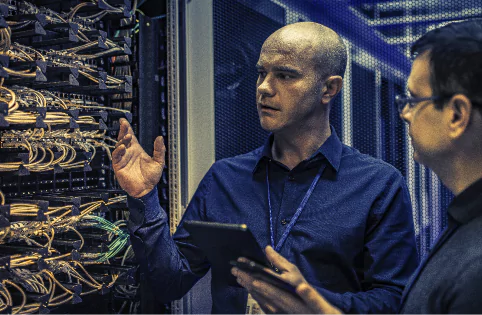What Is Time-Sensitive Networking?

TSN is emerging in all market segments. It can provide the basis for real-time communication for entirely new applications that could not exist before.
Time-Sensitive Networking (TSN) is a set of technologies and standards designed to enable real-time communication in Ethernet networks. It is an important aspect of software development for applications that require low latency, high reliability, and precise timing, such as industrial automation, avionics, and automotive systems.
TSN utilizes a number of different techniques and technologies to enable real-time communication in Ethernet networks, including:
- Time synchronization: TSN uses protocols such as IEEE 1588 and 802.1AS to synchronize the clocks of different devices on the network, ensuring that they all have a common reference point for time. This is critical for ensuring that data is transmitted and received at the correct time.
- Quality of service (QoS): TSN uses QoS mechanisms such as priority-based scheduling and traffic shaping to ensure that time-critical traffic is given priority over other traffic on the network. This helps reduce latency and improve the reliability of time-sensitive communication.
- Redundancy: TSN supports the use of redundant links and protocols, such as rapid spanning tree protocol (RSTP) and multiple spanning tree protocol (MSTP), to provide multiple paths for time-critical traffic to follow, improving the reliability of the network.
- Security: TSN includes mechanisms for ensuring the security of time-sensitive communication, such as the use of encryption and authentication protocols.
TSN is an important aspect of software development for applications that require real-time communication, as it enables developers to design systems that can transmit and receive data with low latency and high reliability. It is also an important component of the Industrial Internet of Things (IIoT), enabling the integration of real-time communication into industrial control systems.
What Do Low Latency and High Reliability Mean?
Low latency and high reliability are important characteristics of computer systems and networks that are used in applications where real-time communication is required.
- Low latency: The amount of time it takes for a system or network to respond to a request or event. It is an important consideration in applications for which timely response is critical, such as industrial automation, avionics, and financial systems. Low-latency systems are able to respond quickly to requests or events, which can improve the efficiency and performance of the system.
- High reliability: The ability of a system or network to perform its intended function without failure. It is an important consideration in applications for which downtime or failure could have serious consequences, such as transportation systems, medical devices, and power plants. High-reliability systems can operate continuously and consistently, which improves the safety and reliability of the system.
Low latency and high reliability are often related, as systems that are able to respond quickly to requests or events are also likely to need to be more reliable. However, it is possible for a system to be highly reliable without having low latency, and vice versa.
What Are Ethernet Networks?

Ethernet is the most widely used networking technology.
Ethernet is a type of computer network technology that is used to connect devices over a local area network (LAN) or wide area network (WAN). It is the most widely used network technology in the world and connects devices such as computers, servers, printers, and routers in homes, businesses, and other organizations. They are also used in industrial automation, transportation, and other applications where real-time communication is required.
Ethernet networks use a protocol called Carrier Sense Multiple Access with Collision Detection (CSMA/CD) to transmit data over a network. This protocol allows devices on the network to listen for network traffic before transmitting data and to detect and handle collisions when two or more devices transmit data at the same time.
Ethernet networks are characterized by their speed, reach, and the number of devices that can be connected. The most common Ethernet speeds are 10 megabits per second (Mbps), 100 Mbps, and 1000 Mbps (also known as 1 gigabit per second or 1 Gbps). Ethernet networks can also be classified by the distance they span and the number of devices they can connect, as in the cases of a local area network vs. a wide area network.
How Can Wind River Help?

VxWorks is proven in the most challenging safety-critical applications.
VxWorks: The Leading RTOS for the Intelligent Edge
VxWorks® enables TSN, guaranteeing real-time communications and packet delivery within a bounded time or latency on a switched Ethernet network. VxWorks is a deterministic, priority-based preemptive real-time operating system with low latency and minimal jitter. It is built on an upgradable, future-proof architecture to help you rapidly respond to changing market requirements and advancements in technology.
VxWorks is the only RTOS to support C++17, Boost, Rust, Python, pandas, and more, as well as having an edge-optimized, OCI-compliant container engine. This means you can use the languages, tools, and technologies you love most to innovate where it matters most.
Key Capabilities of VxWorks
- Reliability and performance: As the first RTOS on Earth as well as on Mars, where reliability is a must-have, VxWorks delivers the highest levels of performance.
- Security: To efficiently and effectively safeguard devices, data, and intellectual property in the connected world, VxWorks provides a comprehensive set of built-in security features that, along with the Wind River® Security Services offering and combined with our development processes, meet rigorous security requirements across industries.
- Safety: VxWorks is developed with safety in mind. It is rigorously tested and has been certified to meet specific regulatory requirements.
Benefits of VxWorks
- Real-time and deterministic
- Safe, secure, certifiable
- Provides broad hardware support
- Provides container support
- AI/ML-ready
Possibilities with VxWorks
A variety of system architectures require an embedded RTOS or use mixed operating systems. The Wind River family of products covers them all, with versions designed for today’s embedded solutions.
Its key features include:
- VxWorks: The most widely trusted and deployed RTOS for critical infrastructure
- VxWorks Cert Edition: VxWorks with safety certification evidence options, to accelerate the certification processes in regulated industries
- VxWorks 653: Designed for integrated modular avionics (IMA) solutions requiring safety certification and conformance with ARINC 653, to support consolidation of critical aeronautical applications on a single compute platform

